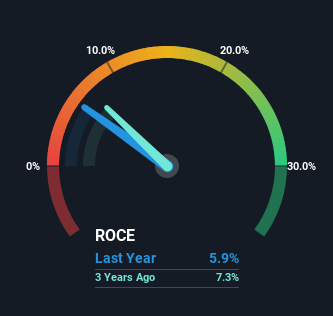- South Korea
- /
- Basic Materials
- /
- KOSE:A004090
Returns At Korea Petroleum Industries (KRX:004090) Are On The Way Up
What trends should we look for it we want to identify stocks that can multiply in value over the long term? Amongst other things, we'll want to see two things; firstly, a growing return on capital employed (ROCE) and secondly, an expansion in the company's amount of capital employed. Basically this means that a company has profitable initiatives that it can continue to reinvest in, which is a trait of a compounding machine. So when we looked at Korea Petroleum Industries (KRX:004090) and its trend of ROCE, we really liked what we saw.
Return On Capital Employed (ROCE): What Is It?
For those who don't know, ROCE is a measure of a company's yearly pre-tax profit (its return), relative to the capital employed in the business. The formula for this calculation on Korea Petroleum Industries is:
Return on Capital Employed = Earnings Before Interest and Tax (EBIT) ÷ (Total Assets - Current Liabilities)
0.059 = ₩14b ÷ (₩384b - ₩156b) (Based on the trailing twelve months to December 2024).
So, Korea Petroleum Industries has an ROCE of 5.9%. In absolute terms, that's a low return but it's around the Basic Materials industry average of 7.0%.
Check out our latest analysis for Korea Petroleum Industries

In the above chart we have measured Korea Petroleum Industries' prior ROCE against its prior performance, but the future is arguably more important. If you'd like, you can check out the forecasts from the analysts covering Korea Petroleum Industries for free.
So How Is Korea Petroleum Industries' ROCE Trending?
Korea Petroleum Industries has not disappointed with their ROCE growth. More specifically, while the company has kept capital employed relatively flat over the last five years, the ROCE has climbed 122% in that same time. So our take on this is that the business has increased efficiencies to generate these higher returns, all the while not needing to make any additional investments. The company is doing well in that sense, and it's worth investigating what the management team has planned for long term growth prospects.
For the record though, there was a noticeable increase in the company's current liabilities over the period, so we would attribute some of the ROCE growth to that. Effectively this means that suppliers or short-term creditors are now funding 40% of the business, which is more than it was five years ago. And with current liabilities at those levels, that's pretty high.
Our Take On Korea Petroleum Industries' ROCE
As discussed above, Korea Petroleum Industries appears to be getting more proficient at generating returns since capital employed has remained flat but earnings (before interest and tax) are up. And with the stock having performed exceptionally well over the last five years, these patterns are being accounted for by investors. Therefore, we think it would be worth your time to check if these trends are going to continue.
Korea Petroleum Industries does come with some risks though, we found 3 warning signs in our investment analysis, and 1 of those is potentially serious...
While Korea Petroleum Industries may not currently earn the highest returns, we've compiled a list of companies that currently earn more than 25% return on equity. Check out this free list here.
Valuation is complex, but we're here to simplify it.
Discover if Korea Petroleum Industries might be undervalued or overvalued with our detailed analysis, featuring fair value estimates, potential risks, dividends, insider trades, and its financial condition.
Access Free AnalysisHave feedback on this article? Concerned about the content? Get in touch with us directly. Alternatively, email editorial-team (at) simplywallst.com.
This article by Simply Wall St is general in nature. We provide commentary based on historical data and analyst forecasts only using an unbiased methodology and our articles are not intended to be financial advice. It does not constitute a recommendation to buy or sell any stock, and does not take account of your objectives, or your financial situation. We aim to bring you long-term focused analysis driven by fundamental data. Note that our analysis may not factor in the latest price-sensitive company announcements or qualitative material. Simply Wall St has no position in any stocks mentioned.
About KOSE:A004090
Korea Petroleum Industries
Manufactures and sells asphalt, solvents, and building materials in South Korea and internationally.
Adequate balance sheet and slightly overvalued.
Market Insights
Community Narratives



